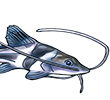New and Noteworthy Venezuelan Glanapterygine Catfishes (Siluriformes, Trichomycteridae), with Discussion of Their Biogeography and Psammophily
SCOTT A. SCHAEFER, FRANCISCO PROVENZANO, MARIO DE PINNA, and JONATHAN N. BASKIN
ABSTRACT
Four new species of the trichomycterid subfamily Glanapteryginae are described from the RÃo Orinoco basin of Venezuela. Two new species each in Pygidianops Myers 1944 and Typhlobelus Myers 1944 represent the first documented occurrence of these genera in Venezuela, and for Pygidianops the first occurrence outside the RÃo Negro basin. The new species were captured from sand-bottom habitats in two disparate locations in the Orinoco River basin and display a remarkable suite of reductive features, such as loss of eyes, fins, and pigment, and reductions or absence of laterosensory canals and odontodes. Pygidianops cuao, n.sp. from the RÃo Cuao, a clear-water tributary of the upper Orinoco River, is diagnosed from its congeners by the presence of diminutive eyes and a triangular skin flap at the corner of the mouth. Pygidianops magoi, n.sp., known from near the delta of the Orinoco River, is diagnosed from its congeners by the absence of pectoral and anal fins, presence of four laterosensory pores, and nine or ten caudal-fin rays. Typhlobelus guacamaya, n.sp. from the RÃo Cuao is diagnosed relative to its congeners by the presence of three branchiostegal rays, posterior naris absent, lack of pleural ribs, and is further distinguished from both T. ternetzi and T. macromycterus by the absence of eyes and from T. lundbergi by the presence of three laterosensory canal pores. Typhlobelus lundbergi, n.sp. from the lower Orinoco is diagnosed by the presence of four laterosensory canal pores and further distinguished from T. ternetzi and T. macromycterus by the absence of eyes. We review the characters useful in diagnoses of Pygidianops and Typhlobelus among trichomycterid catfishes and discuss morphological patterns in the diversification of the Glanapteryginae. Species of Pygidianops and Typhlobelus are known only from the rivers draining the Guyana and Brazilian shields, yet within these areas they occupy all major water types. Such broad ecological range suggests that the geographic distribution of species of these two genera are not limited by water type. That observation, plus their common occurrence in the ubiquitous shallow sand-bottom habitats of the larger rivers of the shield regions of northern South America, indicate that species of Pygidianops and Typhlobelus may be expected to occur throughout the entire Amazon and Orinoco basins. The evolution of habitat preference in glanapterygines seems to follow a trend toward increased specialization for interstitial environments. The degree of psammophilic adaptation in species of Pygidianops and Typhlobelus is remarkable, without parallel in siluriforms and perhaps in any other freshwater fishes. We describe the physical characteristics of the sand and review the suite of morphological specializations for life in interstitial sand that are shared by these species, such as loss or reduction of certain structures and presence in these species of paired metapleural keels along the ventral edges of the abdomen formed by a long ridge of stiffened integument, underlain by well-differentiated medial infracarinalis muscles, that are superficially similar to the metapleural folds of sand-dwelling cephalochordates and other interstitial organisms.




